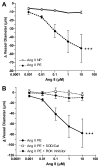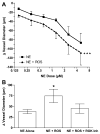Mechanisms of enhanced vascular reactivity in preeclampsia
- PMID: 21947470
- PMCID: PMC3212870
- DOI: 10.1161/HYPERTENSIONAHA.111.176602
Mechanisms of enhanced vascular reactivity in preeclampsia
Abstract
Preeclamptic women have enhanced blood pressure response to angiotensin II and extensive systemic vascular infiltration of neutrophils. Neutrophils release reactive oxygen species that might activate the RhoA kinase pathway to enhance vascular reactivity. We hypothesized that enhanced vascular reactivity in preeclampsia is attributed to neutrophil-mediated reactive oxygen species activation of the RhoA kinase pathway. Omental arteries were obtained at cesarean section and studied using a myograph system. We found that arteries of preeclamptic women had extensive infiltration of neutrophils and enhanced reactivity to angiotensin II. Treatment of arteries of normal pregnant women with reactive oxygen species or activated neutrophils enhanced vessel reactivity to angiotensin II mimicking preeclamptic vessels. Pretreatment with superoxide dismutase/catalase to quench reactive oxygen species or RhoA kinase inhibitor blocked enhanced responses in preeclamptic and normal vessels. Reactive oxygen species also enhanced vessel reactivity to norepinephrine, which was blocked by RhoA kinase inhibition. Treatment of arteries with reactive oxygen species increased RhoA kinase activity 3-fold, whereas culture of human vascular smooth muscle cells with angiotensin II and activated neutrophils or reactive oxygen species resulted in phosphorylation of key proteins in the RhoA kinase pathway. We conclude that enhanced vascular reactivity of omental arteries in preeclampsia is attributed to reactive oxygen species activation of the RhoA kinase pathway and that enhanced vascular reactivity is likely attributed to the infiltration of neutrophils. We speculate that neutrophil infiltration into systemic vasculature of preeclamptic women is an important mechanism for hypertension.
Conflict of interest statement
None
Figures







Comment in
-
Reactive oxygen species and angiotensin II response in human omental arteries: what about tachyphylaxis?Hypertension. 2012 Feb;59(2):e16; author reply e17. doi: 10.1161/HYPERTENSIONAHA.111.187187. Epub 2011 Dec 5. Hypertension. 2012. PMID: 22146508 No abstract available.
Similar articles
-
Pregnancy-specific expression of protease-activated receptor 1: a therapeutic target for prevention and treatment of preeclampsia?Am J Obstet Gynecol. 2022 Feb;226(2S):S945-S953. doi: 10.1016/j.ajog.2021.11.1367. Am J Obstet Gynecol. 2022. PMID: 35177224 Free PMC article. Review.
-
Reactive oxygen species and angiotensin II response in human omental arteries: what about tachyphylaxis?Hypertension. 2012 Feb;59(2):e16; author reply e17. doi: 10.1161/HYPERTENSIONAHA.111.187187. Epub 2011 Dec 5. Hypertension. 2012. PMID: 22146508 No abstract available.
-
Matrix Metalloproteinase 1 Causes Vasoconstriction and Enhances Vessel Reactivity to Angiotensin II via Protease-Activated Receptor 1.Reprod Sci. 2016 Apr;23(4):542-8. doi: 10.1177/1933719115607998. Epub 2015 Oct 4. Reprod Sci. 2016. PMID: 26438597 Free PMC article.
-
Detrimental arterial inflammatory effect of microparticles circulating in preeclamptic women: ex vivo evaluation in human arteries.Fundam Clin Pharmacol. 2015 Oct;29(5):450-61. doi: 10.1111/fcp.12136. Epub 2015 Aug 24. Fundam Clin Pharmacol. 2015. PMID: 26213341
-
Vascular reactivity in preeclampsia.Semin Perinatol. 1999 Feb;23(1):34-44. doi: 10.1016/s0146-0005(99)80058-5. Semin Perinatol. 1999. PMID: 10102169 Review.
Cited by
-
Reduced methylation of the thromboxane synthase gene is correlated with its increased vascular expression in preeclampsia.Hypertension. 2012 Jun;59(6):1249-55. doi: 10.1161/HYPERTENSIONAHA.111.188730. Epub 2012 Apr 9. Hypertension. 2012. PMID: 22493072 Free PMC article.
-
Toll-like receptor 9 activation: a novel mechanism linking placenta-derived mitochondrial DNA and vascular dysfunction in pre-eclampsia.Clin Sci (Lond). 2012 Oct;123(7):429-35. doi: 10.1042/CS20120130. Clin Sci (Lond). 2012. PMID: 22671429 Free PMC article.
-
Lower circulating angiotensin II levels are related to the severity of preeclampsia and its risk as disclosed by a specific bioassay.Medicine (Baltimore). 2018 Sep;97(39):e12498. doi: 10.1097/MD.0000000000012498. Medicine (Baltimore). 2018. PMID: 30278540 Free PMC article.
-
Preeclampsia is associated with alterations in DNA methylation of genes involved in collagen metabolism.Am J Pathol. 2012 Oct;181(4):1455-63. doi: 10.1016/j.ajpath.2012.06.019. Epub 2012 Aug 3. Am J Pathol. 2012. PMID: 22863954 Free PMC article.
-
Pregnancy-specific expression of protease-activated receptor 1: a therapeutic target for prevention and treatment of preeclampsia?Am J Obstet Gynecol. 2022 Feb;226(2S):S945-S953. doi: 10.1016/j.ajog.2021.11.1367. Am J Obstet Gynecol. 2022. PMID: 35177224 Free PMC article. Review.
References
-
- Cunningham G. In: Williams Obstetrics. 22. Cunningham G, editor. McGraw Hill Inc. Companies; 2005.
-
- Brown MA. The physiology of pre-eclampsia. Clin Exp Pharmacol Physiol. 1995;22:781–791. - PubMed
-
- Brown MA, Wang J, Whitworth JA. The renin-angiotensin-aldosterone system in pre-eclampsia. Clin Exp Hypertens. 1997;19:713–726. - PubMed
-
- de Jong CL, Dekker GA, Sibai BM. The renin-angiotensin-aldosterone system in preeclampsia. A review. Clin Perinatol. 1991;18:683–711. - PubMed
Publication types
MeSH terms
Substances
Grants and funding
LinkOut - more resources
Full Text Sources

